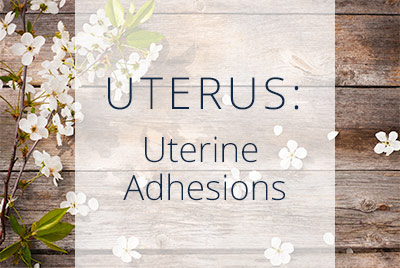What is Uterine Adhesions and Scarring?
 The inside of the uterus is similar to a balloon with the front and back walls flat against each other. The inside is lined with tissue called endometrium and during menstruation, the superficial (top) layer of the endometrium is shed. When you become pregnant, the embryo implants in the endometrium.
The inside of the uterus is similar to a balloon with the front and back walls flat against each other. The inside is lined with tissue called endometrium and during menstruation, the superficial (top) layer of the endometrium is shed. When you become pregnant, the embryo implants in the endometrium.
Endometrium Injuries and/or infections may damage the lining and cause the formation of adhesions (scar tissue) between the inner walls of the uterus where the walls, at times, abnormally adhere or stick to each other. Also known as Asherman’s syndrome is a term used to describe adhesions inside the uterus. This scarring can be mild with thin stretchy bands of scar tissue or severe with the formation of thick bands. In the most severe cases, partial or total occlusion or destruction of the inside of the uterine cavity can occur.
Uterine adhesions also referred to as intrauterine adhesions, and scarring are essentially areas of scar tissue on the uterus. Adhesions can vary in their severity and need for treatment.
Although the formation of scar tissue and adhesion formation is a normal part of the healing process, adhesions can be problematic because they cause parts of the body that are not normally connected to stick to each other. For example, the intestine may become connected by adhesions to the uterus, or the fallopian tube may stick to the ovary. Scar tissue is very tough and lacks the flexibility and elasticity of normal tissue. Thus, adhesions impair the normal movement of the pelvic organs and can cause pain.
Symptoms of Asherman’s Syndrome (Uterine Adhesions)
In some cases, adhesions cause no symptoms at all, but the most common symptoms include:
- Very light periods or no periods (amenorrhea). This can occur if scar tissue is replacing the endometrium, which is the tissue that breaks down and bleeds during a normal menstrual cycle. Occasionally, scar tissue blocks the cervical opening, stopping the flow of menstrual blood.
- Pelvic pain and severe menstrual cramping
- Difficulty getting pregnant or recurrent miscarriage. Uterine scarring lowers one’s ability to get pregnant because it decreases the blood supply to the endometrial lining.
Causes of Asherman’s Syndrome (Uterine Adhesions)
Uterine adhesions are usually caused by damage to the uterine tissue, however, sometimes the precise cause of a patient’s adhesions is unknown.
The most common cause of uterine adhesions is an injury following a surgical procedure involving the cavity of the uterus. Dilation and curettage is a common outpatient surgical procedure during which the cervix is stretched and the tissue contents of the uterus are removed. Uterine adhesions may form following pregnancy complications, such as uterine bleeding following childbirth or miscarriage. Less commonly, for gynecologic problems that involve the uterus such as abnormal bleeding. At times, possible causes of adhesion formation are infections of the uterine lining (endometritis), surgical removal of fibroids in the cavity of the uterus, cesarean sections, and endometrial ablation (a surgical procedure that is used to intentionally damage the uterine lining to make menstrual periods lighter or eliminate them entirely).
Diagnosing Asherman’s Syndrome (Uterine Adhesions)
If you have these symptoms, you should make an appointment with your doctor. Uterine scarring can be seen on imaging such as hysterosalpingogram which is an X-ray of the pelvis, pelvic ultrasound, and saline sonogram which an ultrasound with sterile water. We may perform a hysteroscopy to examine the uterine lining and check for adhesions. A hysteroscopy is a procedure in which we insert a thin, flexible, lighted telescope into the vagina and through the cervix to directly view the inside of the uterus.
We may also perform a transvaginal ultrasound to measure the thickness of your endometrium, and a biopsy of the uterine lining to test whether you still have any normal endometrial tissue.
Treatment for Asherman’s Syndrome (Uterine Adhesions)
If your adhesions aren’t causing you any pain and you’re not planning on getting pregnant in the future, you may not need treatment at all. You can talk with your OB-GYN about your options and the implications of non-treatment. Treating adhesions of the uterus generally involves breaking up the scar tissue and trying to prevent scar tissue from reforming in its place.
To remove the scar tissue, your gynecologist may perform hysteroscopic lysis of adhesions. This is an outpatient procedure in which the doctor uses a hysteroscope to view the lining of the uterus and agitate the scar tissue that’s present. If the scar tissue is sparse and filmy, the doctor may be able to use the hysteroscope itself to break it apart. If it’s significantly denser, surgical scissors can be used.
Scar tissue can be prevented from growing again in a few different ways:
Hormone therapy
You may be prescribed a 30-day regimen of oral estrogen to help the uterus clear itself of its old tissue and regrow a healthy endometrium.
Intrauterine balloon
An inflated medical balloon or an IUD placed in the cavity of the uterus can help the uterus regrow normal tissue.
Repeated hysteroscopy
Typically, your doctor will schedule you for a second or third hysteroscopy after about a week or two following the previous one. This is to break up any remaining scar tissue and ensure that all of the scar tissue has been removed.
Recovery from hysteroscopic lysis of adhesions can vary, although most women get their normal period again, are able to become pregnant, and are able to carry the pregnancy to term.

